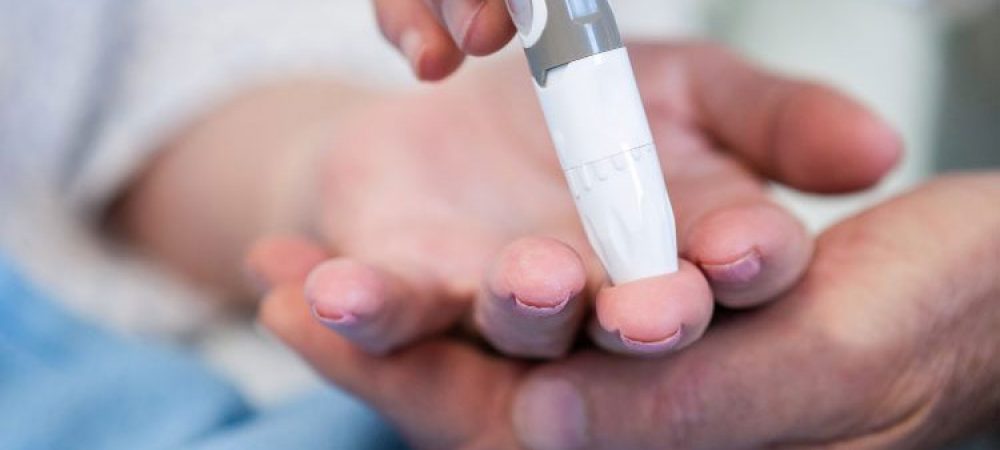Alcoholism & Diabetes
Excessive alcohol use can increase someone’s risk of developing diabetes and may have harmful effects on an already diagnosed individual. An individual with diabetes can establish safe drinking limits and habits to reduce risk; however, it can be difficult for someone who suffers from alcoholism to engage in these habits. If you presume that you or someone you love is experiencing alcoholism, it is essential to seek help right away.

What is Diabetes?
Diabetes develops when the affected individual’s pancreas can no longer produce insulin or when their body can no longer effectively utilize its insulin. (1) Diabetes is a chronic health condition that impacts the body’s ability to turn food into energy. (2)
Most foods, and all carbohydrates, are broken down into sugar, or glucose, which releases into the bloodstream. When the blood sugar in the body increases, the pancreas is signaled to release insulin. (2) Insulin is a hormone that allows glucose to pass from the bloodstream into the body’s cells to produce energy for the body to use. (1)
When the body cannot produce insulin or use it effectively, the glucose levels in the blood rise to an abnormal level. This heightened level of glucose in the bloodstream is known as hyperglycemia. (1) Over time, high glucose levels can create serious health issues, including heart disease, vision loss, and kidney disease. (2)
While there is currently no cure for diabetes, practices such as losing weight, eating healthy foods, and maintaining an active lifestyle can benefit an individual with diabetes. Additionally, taking medication, receiving education and support regarding diabetes self-management, and attending regular healthcare appointments can also reduce the impacts of diabetes. (2)
Diabetes Statistics
- 34.2 million adults in the United States have diabetes
- 1 out of 5 individuals with diabetes do not know they have it
- Diabetes is the seventh leading cause of death in the US
- Diabetes is the first leading cause of kidney failure, lower-limb amputations, and adult blindness
- The number of adults diagnosed with diabetes has more than doubled in the last 20 years
Types of Diabetes
There are three main types of diabetes, including type 1, type 2, and gestational diabetes. (2) An individual may also develop prediabetes before becoming diabetic.
Type 1 Diabetes
Type 1 diabetes is usually developed in children and adolescents but can occur at any age. (1) This type of diabetes accounts for 5-10% of diabetes cases, and the symptoms typically occur very quickly. (2)
Type 1 diabetes is most likely caused by an autoimmune reaction in which the body attacks itself by mistake and stops the body from producing insulin. (2) Type 1 diabetes is characterized by very little or no insulin production in the body. (1)
People who are diagnosed with this type of diabetes need to take insulin injections daily to survive. There is presently no known prevention of type 1 diabetes. (2)
Type 2 Diabetes
Type 2 diabetes is usually developed over many years and diagnosed in adulthood. (1) However, an increasing number of children, teens, and young adults are experiencing type 2 diabetes diagnoses. Approximately 90-95% of individuals with diabetes have this type, and the symptoms may sometimes go unnoticed. (2)
Type 2 diabetes is characterized by the body’s inability to effectively use the insulin that it produces and maintain normal blood sugar levels. (2) Maintaining a healthy lifestyle, which includes regular physical activity and healthy eating habits, can prevent or delay the development and symptoms of this type of diabetes. However, most individuals with type 2 diabetes will eventually require oral drugs or insulin to regulate glucose levels in the bloodstream. (1)
Gestational Diabetes
Gestational diabetes occurs during pregnancy in women who have never had a previous diagnosis of diabetes. (2) This type of diabetes is characterized by high blood glucose during pregnancy and can create complications for the mother and her child. (1)
Gestational diabetes typically goes away after the baby is born but increases the mother’s and child’s risk of developing type 2 diabetes later in life. (1) The child is also more likely to experience obesity as a child or teen. (2)
Prediabetes
Over 1 out of 3, or 88 million, United States adults have prediabetes, and over 84% of these individuals are unaware that they have it. Prediabetes is characterized by heightened blood sugar levels that are not yet high enough for a type 2 diabetes diagnosis. (2)
Prediabetes can increase an individual’s risk of developing type 2 diabetes, heart disease, and stroke. Fortunately, making and maintaining healthy lifestyle changes can ultimately reverse prediabetes. (2)
Signs and Symptoms of Diabetes
Early Signs of Diabetes
Type 1 and type 2 diabetes share some early signs and symptoms, including: (3)
- Hunger and fatigue. The body’s inability to produce or effectively utilize insulin decreases energy, which can cause someone to feel hungrier or more tired than they usually do.
- Increased urination and thirst. The average individual urinates between 4 to 7 times in 24 hours. People with diabetes may urinate more frequently because their kidneys cannot effectively reabsorb glucose as they usually would due to increased blood sugar. This lack of reabsorption of glucose in the kidneys causes the body to create more urine. The increase in urination causes an increase in thirst.
- Dry mouth and itchy skin. The body is using fluids to create urine which means less moisture in the body for other things. This lack of moisture can create a dry mouth due to dehydration. The skin may also become dry, which causes it to itch.
- Blurred vision. A change In fluid levels in the body can cause the lenses in the eyes to swell up, causing them to change shape and lose focus.
Symptoms of Type 1 Diabetes
Symptoms of type 1 diabetes include: (3)
- Unexpected weight loss. When the body doesn’t get enough energy from food, it begins burning muscle and fat for necessary energy, which can cause weight loss even when eating habits are unchanged.
- Nausea and vomiting. When the body begins burning fat for energy, it creates ketones, making someone feel sick to their stomach. Ketones can build up in the bloodstream to dangerous levels, resulting in diabetic ketoacidosis, a life-threatening condition.
Lorem ipsum dolor sit amet, consectetur adipiscing elit. Ut elit tellus, luctus nec ullamcorper mattis, pulvinar dapibus leo.
Symptoms of Type 2 Diabetes
Symptoms of type 2 diabetes usually show up after glucose in the body has been high for a long time. These symptoms include: (3)
- Yeast infections. Men and women with diabetes can experience yeast infections. Yeast feeds on glucose, so having heightened glucose levels in the body can help yeast grow. These types of infections often grow in warm, moist folds of skin, including:
- Between fingers and toes
- Under breasts
- In or around sex organs
- Slow-healing sores or cuts. High blood sugar can affect blood flow over time and create nerve damage. This nerve damage makes it difficult for the body to heal wounds.
- Pain or numbness in feet or legs. Nerve damage can also cause this kind of pain or numbness.
Symptoms of Gestational Diabetes
There are typically no symptoms of high blood sugar during pregnancy. A woman with gestational diabetes may experience an increase in thirst or more frequent urination. (3)
Gestational Diabetes
Gestational diabetes occurs during pregnancy in women who have never had a previous diagnosis of diabetes. (2) This type of diabetes is characterized by high blood glucose during pregnancy and can create complications for the mother and her child. (1)
Gestational diabetes typically goes away after the baby is born but increases the mother’s and child’s risk of developing type 2 diabetes later in life. (1) The child is also more likely to experience obesity as a child or teen. (2)
Causes of Diabetes
Causes of Type 1 Diabetes
The exact cause of type 1 diabetes is not known. However, it is known that the immune system, which, when functioning normally, fights harmful bacteria and viruses, attacks and destroys the cells in the pancreas that produce insulin in type 1 diabetes. Little or no insulin levels in the body causes sugar to build up in the bloodstream rather than transporting to the cells. (4)
Type 1 diabetes may be caused by a combination of genetic and environmental factors. Exactly what these factors are is unclear; however, weight is not believed to be a cause of type 1 diabetes. (4)
Causes of Type 2 Diabetes and Prediabetes
The exact cause of type 1 diabetes is not known. However, it is known that the immune system, which, when functioning normally, fights harmful bacteria and viruses, attacks and destroys the cells in the pancreas that produce insulin in type 1 diabetes. Little or no insulin levels in the body causes sugar to build up in the bloodstream rather than transporting to the cells. (4)
Type 1 diabetes may be caused by a combination of genetic and environmental factors. Exactly what these factors are is unclear; however, weight is not believed to be a cause of type 1 diabetes. (4)
Causes of Type 2 Diabetes and Prediabetes
Prediabetes and type 2 diabetes are characteristic of the cells’ resistance to the action of insulin and the pancreas’ inability to make enough insulin to overcome this, causing sugar to build up in the bloodstream. Prediabetes can eventually lead to type 2 diabetes. (4)
The exact cause of prediabetes and type 2 diabetes is uncertain. Like type 1 diabetes they are likely caused by a combination of genetic and environmental factors. Weight is strongly linked to the development of type 2 diabetes; however, not everyone with type 2 diabetes is overweight. (4)
Causes of Gestational Diabetes
When a woman is pregnant, her placenta produces hormones that will sustain her pregnancy. These hormones also make the woman’s cells more resistant to insulin. In most cases, her pancreas will produce enough extra insulin to overcome the resistance. Unfortunately, in some cases, her pancreas is unable to do so. This inability to create enough insulin causes an increase in sugar in the bloodstream, leading to gestational diabetes. (4)
Risk Factors For Diabetes
Risk Factors for Type 1 Diabetes
Even though the exact cause of type 1 diabetes is unknown, some factors may be present in an individual that can place them at an increased risk. These include: (4)
- Family history. Risk increases if a parent or sibling experiences type 1 diabetes.
Environmental factors. Exposure to a viral illness can increase someone’s likelihood of developing type 1 diabetes. - Damaging immune systems cells (autoantibodies). The presence of diabetes autoantibodies can increase the risk of type 1 diabetes. However, not everyone with these antibodies will develop diabetes.
- Geography. Certain countries, like Finland and Sweden, have higher rates of individuals with type 1 diabetes
Risk Factors for Prediabetes and Type 2 Diabetes
While the exact cause of prediabetes and type 2 diabetes is unknown, specific factors may increase risk. These factors include: (4)
- Weight. More fatty tissue in the body causes the cells to become more resistant to insulin.
Inactivity. The less active an individual is, the more likely they are to develop prediabetes or type 2 diabetes. Physical activity is beneficial for weight control and uses glucose as energy, making the cells more reactive to insulin. - Family history. Having a parent or sibling with type 2 diabetes increases risk.
- Race or ethnicity. Certain people, including Black, Hispanic, American Indian, and Asian individuals, are at a higher risk.
- Age. Someone’s risk of developing prediabetes or type 2 diabetes increases as they age. This increase in risk with age may be due to decreased exercise, lost muscle mass, and weight gain.
- Gestational diabetes. Having had gestational diabetes during pregnancy can increase a woman’s risk of developing prediabetes and type 2 diabetes. Having given birth to a baby weighing more than 9 pounds can also increase risk.
- High blood pressure. An individual with blood pressure over 140/90 millimeters of mercury has an increased risk.
- Polycystic ovary syndrome. Women with polycystic ovary syndrome, which includes irregular menstrual cycles, excess hair growth, and obesity, have an increased risk of developing prediabetes and type 2 diabetes.
- Abnormal cholesterol and triglyceride levels. Low levels of high-density lipoprotein, or “good” cholesterol, can create increased risk. High levels of triglycerides can also increase risk.
Risk Factors for Gestational Diabetes
Some women are at greater risk of developing gestational diabetes than others. Risk factors include: (4)
- Age. Women over the age of 25 have a higher risk.
- Family or personal history. Having prediabetes, or a parent or sibling with type 2 diabetes, can increase risk. Having had gestational diabetes during a previous pregnancy, a large baby or an unexplained stillbirth can also increase risk.
- Weight. A woman who is overweight before her pregnancy is at greater risk of developing gestational diabetes.
- Race or ethnicity. Women who are Black, Hispanic, American Indian, or Asian American have a higher risk.

Alcohol and Diabetes
In addition to the risk factors mentioned above, alcohol use can also increase an individual’s risk of developing type 2 diabetes. While studies show that drinking in moderation can lower the risk of developing diabetes, drinking alcohol in excess can increase someone’s likelihood. (5)
Moderate drinking refers to one drink a day for women of all ages and men over 65 and two drinks a day for men younger than 65. Drinking this amount can be beneficial. However, drinking an excessive amount of alcohol can cause chronic inflammation of the pancreas, which impacts its ability to secrete insulin and can eventually lead to diabetes. (5)
Additionally, it is difficult for the liver to engage in multiple functions at once. When alcohol is consumed, the liver chooses to metabolize the alcohol instead of maintaining blood sugar, leading to hypoglycemia, and ultimately diabetes. (6)
Effects of Alcohol on Diabetes
Heavy alcohol consumption is not only a risk factor for developing diabetes. It can also be detrimental to someone who already has diabetes. Drinking alcohol can cause blood sugar to rise or fall and is loaded with calories. (7)
Excessive alcohol use can also affect diabetes by:
- Decreasing blood sugar. In some cases, alcohol use can cause blood sugar to drop to dangerous levels for someone with diabetes, primarily type 1
- Raising blood sugar. Beer and sweet wine contain a lot of carbohydrates, which can raise blood sugar
- Stimulating appetite. A stimulated appetite can cause overeating which can also affect the control of blood sugar
- Decreasing the body’s ability to lose excess weight. Alcoholic beverages often contain a high amount of calories, which can make it challenging to lose weight
- Affecting judgment and willpower. Poor judgment can cause someone to make unhealthy choices with food, which can be dangerous for someone with diabetes
- Interfering with diabetes medications. Alcohol, especially in high doses, can interfere with the positive effects of oral medication and insulin
- Increasing blood pressure, and triglyceride levels
- Worsening diabetes-related medical complications. These medical complications include disturbances in fat metabolism, nerve damage, and eye disease
Increasing certain acids in the body. The accumulation of these acids in the blood can result in severe health consequences
Tips for Alcohol Consumption with Diabetes
Individuals who have diabetes or prediabetes, and drink alcohol, should engage in the following practices: (7)
- Refrain from drinking more than two drinks in one day for men and one drink per day for women.
- Drink alcohol only with food.
- Consume alcohol slowly.
- Avoid sweet wines and mixed drinks that are “sugary.”
- Mix liquors with water, club soda, or diet sodas.
Signs and Symptoms of Alcoholism
Signs and symptoms of alcoholism may include: (9)
- An inability to limit the amount of alcohol consumed in a night of drinking
- A desire to reduce the amount of alcohol consumed, with an inability to do so
- An increased amount of time spent drinking, getting alcohol, or recovering from hangovers
- Strong cravings or urges to drink alcohol
- Difficulty fulfilling significant obligations at work, school, or home due to alcohol use
- A continuation of alcohol use even when it is causing physical, social, or relational issues
- A reduction in engagement with social and work activities and hobbies
- Alcohol use in unsafe situations, for example, when driving or swimming
- Increased tolerance to alcohol, creating a need to use more to feel its effects
- Withdrawal symptoms, such as nausea, sweating and shaking, when not drinking
Help is Available For You or Your Loved One
If you or a loved one are struggling with alcoholism and need help there are many addiction treatment centers available to treat patients who have comorbidity with Alcohol Use Disorder and Diabetes. Please feel free to reach out to one of our addiction specialists for more information on finding the right treatment prorgam.
Sources
What is diabetes? (2020). International Diabetes Federation. https://www.idf.org/aboutdiabetes/what-is-diabetes.html
What is Diabetes? (2021, November 16). Centers for Disease Control and Prevention. https://www.cdc.gov/diabetes/basics/diabetes.html
Early Signs and Symptoms of Diabetes. (2003, February 14). WebMD. https://www.webmd.com/diabetes/guide/understanding-diabetes-symptoms
Diabetes – Symptoms and causes. (2020, October 30). Mayo Clinic. https://www.mayoclinic.org/diseases-conditions/diabetes/symptoms-causes/syc-20371444
Diabetes: Does alcohol and tobacco use increase my risk? (2020, July 11). Mayo Clinic. https://www.mayoclinic.org/diseases-conditions/type-2-diabetes/expert-answers/diabetes/faq-20058540
Medication & Treatments Alcohol & Diabetes. (2020). American Diabetes Association. https://www.diabetes.org/healthy-living/medication-treatments/alcohol-diabetes
Ambardekar, MD, N. (2001, October 25). Diabetes and Alcohol. WebMD. https://www.webmd.com/diabetes/guide/drinking-alcohol
Emanuele, N. (1998). Consequences of Alcohol Use in Diabetics. National Center for Biotechnology Information. https://www.ncbi.nlm.nih.gov/pmc/articles/PMC6761899/
Alcohol use disorder – Symptoms and causes. (2018b, July 11). Mayo Clinic. https://www.mayoclinic.org/diseases-conditions/alcohol-use-disorder/symptoms-causes/syc-20369243
